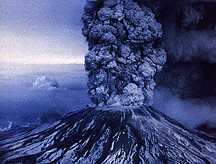 Photo Caption and Credits
Photo Caption and Credits
A general education course. Although the earth's crust appears very stable and permanent, subtle as well as significant changes occur continuously. Ice ages have slowly altered topography and ecology, and processes associated with tectonic deformation of the earth's crust (earthquakes, tsunamis, volcanism) have caused abrupt though more localized changes. These changes will be examined through case studies ranging from the influence of crustal rifting in eastern Africa on the development of Australopithecus, and the effects of climatic variations on Cro-Magnon in Europe, to the destruction of the Minoan civilization by volcanic eruptions and the results of the Good Friday earthquake and the Mount Saint Helens eruptions on homo sapiens.
COURSE FORMAT: Lecture
Level: UG Credit: 1.00 Gen Ed Area & Dept: NSM E&ES
Prerequisites: None
Last Updated on MAR-10-1997
The Mount St. Helens eruption of May 1980 released tons of ash into the atmosphere and levelled 594 square kilometers of surrounding forest
Duxbury, Alyn C. and Alison B. AN INTRODUCTION TO THE WORLD'S OCEANS, 4ed, Dubuque, IA: Wm. C. Brown Publishers, 1994
Copyright Wesleyan University, Middletown, Connecticut, 06459